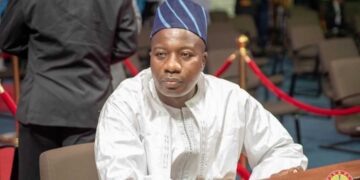Donald Trump announced a massive tariff plan last week that would have upended the global economic order as well as long-established trading relationships with America’s allies.
But that plan – or at least a significant part of it – is on ice after the president suspended higher tariffs on most countries for 90 days while leaning into a trade war with China.
So with this partial reversal, is Trump any closer to realising his goals on trade? Here’s a quick look at five of his key ambitions and where they now stand.
1) Better trade deals
WHAT TRUMP SAID: For decades, our country has been looted, pillaged, and plundered by nations near and far, both friend and foe alike
Trump’s original trade plan packed a big punch that landed around the world, with a flat 10% baseline tariff on everyone (including some uninhabited islands) and additional “reciprocal” tariffs on the 60 countries that he said were the worst offenders.
It sent allies and adversaries scrambling, as they stared down the prospect of a debilitating blow to their economies.
The White House has been quick to boast about all the world leaders who have reached out to the president to make deals and offer trade concessions – “more than 75”, according to Treasury Secretary Scott Bessent.
Although the administration hasn’t released a list of all the countries that Trump said on Tuesday were “kissing my ass” and promising to do anything, the US has announced it is in negotiations with South Korea and Japan, among others.
THE TAKEAWAY: America’s trading partners have 90 days to strike some sort of agreement with Trump, and the clock is ticking. But the fact that talks are happening indicates that the president has a good chance of getting something for his efforts.
2) Boosting American industry
WHAT TRUMP SAID: Jobs and factories will come roaring back into our country…We will supercharge our domestic industrial base.
Trump has said for decades that tariffs are an effective way of rebuilding America’s manufacturing base by shielding it from unfair foreign competition. While some factories may be able to increase production in current facilities, more substantive efforts take time. And for business leaders to pull the trigger on “reshoring” their production lines and investing in new US factories, they will want to know that the rules of the game are relatively stable.
The president’s on-again, off-again tariff moves over the past week are inherently unstable, however. For the moment, it’s difficult to predict where the final tariff levels will land and which industries will receive the greatest protections. It could be car manufacturers and steel producers today, and high-tech electronics companies tomorrow.
THE TAKEAWAY: When tariffs are applied and removed seemingly at the president’s whim, it’s much more likely that companies – both in the US and abroad – will hunker down and wait for the dust to settle before making any big commitments.
3) Facing off with China
WHAT TRUMP SAID: I have great respect for President Xi of China, great respect for China, but they were taking tremendous advantage of us.
After Trump’s tariff about-face on Wednesday, several White House officials – including Treasury Secretary Bessent – were quick to say that Trump’s goal was to drop the hammer on the real villain, China.
“They are the biggest source of the US trade problems,” Bessent told reporters, “and indeed they are the problem for the rest of the world.
If Trump wanted a battle of wills with China, testing each side’s tolerance for economic and political pain, he got one – even if the president and his aides have hinted that they are looking for an exit ramp.
On Wednesday, Trump said that he blamed past US leaders, not China, for the current trade dispute. The prior day, White House press secretary Karoline Leavitt said the president would be “incredibly gracious” if China reaches out to make a deal.
THE TAKEAWAY: Even if this showdown is one Trump wants, picking a fight with the second-largest economy in the world, with military power to match, comes at enormous risk. And along the way America may have alienated the allies it needs most in such a confrontation.
4) Raising revenue
WHAT TRUMP SAID: Now it’s our turn to prosper, and in so doing, use trillions and trillions of dollars to reduce our taxes and pay down our national debt, and it’ll all happen very quickly.
During last year’s presidential campaign, Trump regularly touted that his proposed tariffs would bring in vast sums in new revenue, which the US could then use to shrink its budget deficit, fund tax cuts and pay for new government programmes.
A study last year by the nonpartisan Tax Foundation estimated that a 10% universal tariff – which is what Trump has landed on for at least the next 90 days – would generate $2tn in new revenue over the next 10 years.
To put that in context, the tax cuts Congress recently included in its non-binding budget blueprint would cost approximately $5tn over the next 10 years, according to the Bipartisan Policy Center.
THE TAKEAWAY: Trump wanted more tariff revenue, and if he sticks with his baseline tariffs, plus the additional levies on certain imports and larger ones on China, he’s going to get it – at least until Americans switch to more domestic production, when the tariff money gusher could turn to a trickle.
5) Lower prices for US consumers
WHAT TRUMP SAID: Ultimately, more production at home will mean stronger competition and lower prices for consumers. This will be indeed the golden age of America.
Analysts and experts have offered a grab bag of other explanations about why Trump made such an aggressive move on trade last week. Was he trying to drive down interest rates, or devalue the US dollar or bring the world to the table for a new, global agreement on trade? The president himself hasn’t spoken much about those kinds of elaborate schemes.
One thing he has talked about relentlessly, however, is his desire to lower costs for American consumers – and he has promised that his trade policy will help address this. While energy prices dipped in the week since Trump announced his tariff plan, that may have been a result of fears that the trade wars could trigger a global recession.
The consensus among economists is that new tariffs will drive up consumer prices, as tariffs are tacked on to the price of imports and, eventually, when there is less competition for US-made products. Last year, the Tax Foundation estimated that a 10% universal tariff would increase costs for American households by an average of $1,253 in its first year. Economists also warn that lower-income Americans will be hardest hit.
THE TAKEAWAY: An increase in prices is an arrow moving in the wrong direction – and it represents an enormous potential liability for both Trump’s political standing and his party’s future electoral prospects.
BBC





















































































